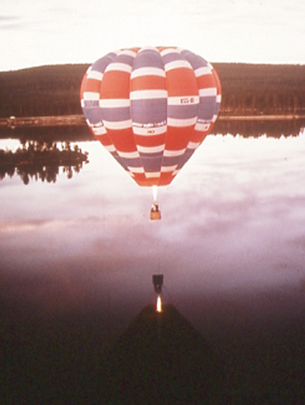Module 3 Intro
1. Module 3 Intro
1.9. Lesson 2 Intro
Module 3—Behaviour of Gases
Lesson 2—Kelvin Temperature, Charles’ Law, and the Combined Gas Law
 Get Focused
Get Focused
On a cold winter day in Alberta, temperatures may be around –30°C. On a hot summer day in Alberta, the temperature may be around 30°C. Is it easier to breathe in cold weather or hot weather? You probably find that it is more difficult to breathe when it is cold outside. This isn’t purely temperature dependent, however. Other factors, such as humidity, also affect breathing.
 Try This
Try This

Step 1: Inflate a balloon.
Step 2: Measure the size of the balloon.
Step 3: Place the balloon into a freezer (typically around –18°C), and leave it there for ten minutes.
Step 4: Remove the balloon from the freezer and quickly determine its size.
Does the balloon get bigger or smaller when it is cooled?
In Lesson 1 you learned that the pressure of a gas is the result of the collisions of the gas molecules against the surfaces of its container. Do you recall how temperature affects the motion of particles? How would this explain the change in the size of the balloon upon cooling and heating?
The investigation you completed identifies an important relationship between temperature and volume of a gas. This relationship was first described by Jacques Charles—a French chemist, physicist, and aeronaut. In 1783, Charles made the first hot-air balloon using hydrogen gas and ascended to a height of nearly 3 km. Charles’ work with hot-air balloons set the stage for his discovery of the relationship between temperature and volume.
In this lesson you will investigate this relationship, as well as consider the relationship of pressure, volume, and temperature for a fixed amount of gas.
Essential Questions
- What is the Kelvin temperature scale, and why is it used?
- What are the relationships among pressure, volume, amount, and temperature for a fixed amount of gas?
 Module 3: Lesson 2 Assignment
Module 3: Lesson 2 Assignment
Save a copy of the Module 3: Lesson 2 Assignment to your course folder. Later in the lesson you will receive more information about how to complete this assignment and when to submit it to your teacher.
You must decide what to do with the questions that are not marked by the teacher.
Remember that these questions provide you with the practice and feedback that you need to successfully complete this course. You should respond to all the questions and place those answers in your course folder.